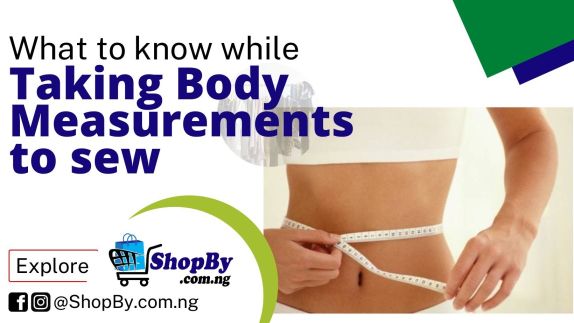- Your cart is empty
- Continue Shopping
What to know while taking Body Measurements to sew

How to sew ShopBy Online Mall
What are Textile?
Without a doubt, these are any material created by weaving or knitting fibers. The word “textile” covers a broad range of fiber-based goods, including fibers, yarns, filaments, threads, and other fabric types. Traditionally, “textiles” has exclusively referred to woven clothing. READ MORE on SIMPLE AND LIGHT FABRICS FOR EASY SEWING
Things to know while taking Body Measurements
Standing with their feet around 15 cm apart, the subject of the measurement should be straight.
For best results, measure while wearing fitting clothing. No baggy attire at all. The results may be off because of this.
The ideal situation would be if you could take the measurement while wearing the undergarment you plan to wear with the finished item. This is particularly crucial when wearing carefully tailored clothing, such as a corset, tight gown, or fitting blouse. In terms of your overall appearance, a push-up bra is crucial. Keeping this in mind, you should think about whether you want to wear underwired, padded, push-up, or other figure-altering bras.
When obtaining measurements, remember to wear heels or something similar if you intend to wear heels and are designing a long gown. Select a reliable and precise tape measure. When taking horizontal measurements, always keep it level (parallel to the ground). Observe the proverb “Measure twice, cut once” It is ideal if you can have a second person take the measurements. The person taking the measurement ought to be standing to the right of the subject.
Every circumference measurement needs to be done with the tape measure parallel to the ground and with just enough slack to let two fingers fit beneath the tape.
Do not expect that the garment will be flawless just because you forced your breath in. No, it won’t.
The tape measure and doctors should not be lied to.
Consider the Allowance
You should accurately measure the area to be fitted, then add ease to the pattern as desired. Options range from very loose to somewhat loose to fitting to tight. Once you have taken the person’s measurement if you are measuring someone else, find out what ease they require for this specific outfit. Put it in writing. For comfort, a minimum of 2 inches is required, which is why I’ve included the bodice pattern in this post. This is my judgment, which is highly influenced by personal choice.
READ MORE on How to wash Fabrics with your bare hands
Different Aspect of Measurement
- Compound measuring
- Shoulder measuring
- Chest measuring
- Direct measuring
Compound measuring
you will use this approach to collect more precise measures such armhole depth, across the chest, over the shoulder, waist round, and sleeve length for a blouse. You must measure the following for a jacket: the breast, waist, hips, sleeve, full, neck, and back widths.
Method for Measuring shoulders
The upper shoulder, middle shoulder, lower shoulder, and nape of the neck to waist are the additional 4 measurements taken by this technique.
Chest measurement
You will be taking the fundamental measurements with this system. You should measure the complete length, shoulder, breast round, waist round, and sleeve length for a blouse. You will just need the waist, hips, entire length, and flare at the bottom to make the trousers. You must measure the following for a jacket: the breast, waist, hips, sleeve, full, neck, and back widths.
Method of Direct measuring
This system is more complex. For a jacket, you will use this approach to collect more precise measures such armhole depth, across the chest, over the shoulder, etc.
What to look out for during Measurements
- Center Back Neck to Waist (from the bone at the base of the neck)
- Center Back Neck to Floor
- Waist to Floor at Center Front
- Knee to Floor at Center Front
- The Bra Size
- Waist to Ankle
- Ankle to Floor
- Total Height
- Front Width (measured across the chest from one underarm crease to other)
- Shoulder to High Point ( taken vertically from neck edge of shoulder seam to high point of Bust) Right & Left
- High Point to High Point ( taken horizontally from one high point to other)
- High Bust ( around body under arms )
- Full Bust
- Midriff ( around body where bottom band of regular band of bra would ride )
- Waist ( around body where elastic waist pants would naturally settle)
- Abdomen ( around body about 4 ” down from waist)
- Hip ( around the body at the fullest part of the hip area )
- Front Shoulder Width (from shoulder bone to shoulder bone)
- Back Shoulder Width (from shoulder bone to shoulder bone)
- Shoulder to Neck (from shoulder bone across shoulder to neck edge)Waist to Floor at Center Back
- Waist to Floor at Right Side
- Waist to Floor at Left Side
- Waist to Knee
- Arm Length Right & Left ( arm slightly bend)
- Right Shoulder to Elbow
- Right Elbow to Wrist
- Left Arm Length
- Left Shoulder to Elbow
- Upper Arm circumference
- ForeArm circumference
- Wrist circumference
Here are some body Measurements Depending on what you want to sew
Measurements needed to make shirts and tops
round bust, round waist, and whole blouse length, Measurements for the shoulders, neck, upper arms, and waist back length
Measurements needed to create a jacket for men or women
For men: Round neck, over-bust, round chest, natural waist Crossing the shoulder from the back, ending at the neck Bicep (around), elbow and wrist movements center of the back, arm length (shoulder to wrist) (neck to wrist)
Women should measure their under-bust, elbow round, bust (nippel to nippel), and bust depth in addition to the measurements for men (Front shoulder neck-to-nipple).
Measurements needed to create dresses
Round shoulders, waists, high hips, and hips, width between the waist and the nape, armhole size, shoulder width, shoulder distance, Bicep curl elbows bent, round the wrist, Height, dress size, from the waist to the knee, hip to waist, Point to bust nape
Measurements needed to make pants and trousers,
full duration ( side length), Long legs (Inseam length), Round Seat and Waist ( Hip round)
bottom benchmark.
CONCLUSION
It is very important to know and understand Bust round, Waist round, High hip round, Hip round, Distance from nape to waist, Armhole depth, Shoulder length, Shoulder point to point, Bicep round
Elbow round, Wrist round, Height, Dress length, Waist to knee length, Waist to hip, Nape to bust point and other parts when it comes to body measurements such that your sewing will look professional. On this article we have been able to supply most of the tips involved to guarantee a great sewing experience.
ShopBy Online Mall got you covered if you need the best of fabrics for any kind of style sewing and printing depending on your teste.
Hope this topic “Types of Fabrics Printing” was helpful, for more info or consultancy Contact Us
READ MORE on TYPES OF FABRICS PRINTING How to sew ShopBy Online Mall
READ MORE on How to wash Fabrics with your bare hands
READ MORE on WHAT SHOULD NEVER BE WORN TO A WEDDING BY GUESTS
READ MORE on Best Bridal Wedding Nail Designs
READ MORE on What to know while taking Body Measurements to sew
READ MORE on HOW TO DO EFFECTIVE MAKE-UP FOR WEDDING BRIDE
READ MORE on What Are Satin Fabrics? How to sew ShopBy Online Mall
READ MORE on Mistakes Made by Makeup Artists in Nigerian
READ MORE on How to sew ShopBy Online Mall Light Fabrics
READ MORE on How to Transfer Photo Print to fabric
READ MORE on How to TIE and DYE Fabrics




